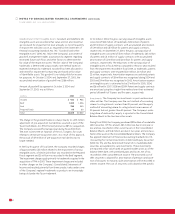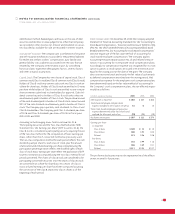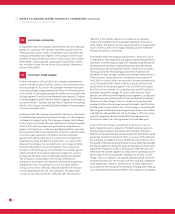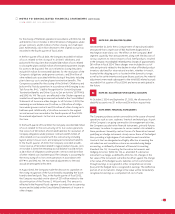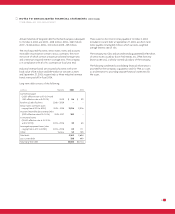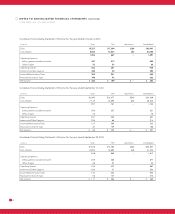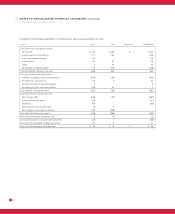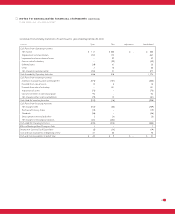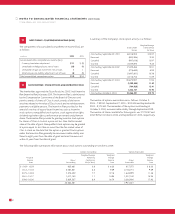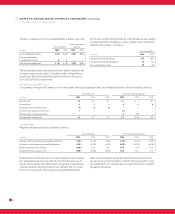Tyson Foods 2004 Annual Report Download - page 44
Download and view the complete annual report
Please find page 44 of the 2004 Tyson Foods annual report below. You can navigate through the pages in the report by either clicking on the pages listed below, or by using the keyword search tool below to find specific information within the annual report.
42
NOTES TO CONSOLIDATED FINANCIAL STATEMENTS (CONTINUED)
NOTE TEN : COMMITMENTS
The Company leases certain farms and other properties and equipment
for which the total rentals thereon approximated $111 million in 2004,
$104 million in 2003 and $105 million in 2002. Most leases have terms
ranging from one to seven years with varying renewal periods. The
most significant obligations assumed under the terms of the leases
are the upkeep of the facilities and payments of insurance and
property taxes.
Minimum lease commitments under non-cancelable leases at
October 2, 2004, totaled $158 million composed of $63 million for
fiscal 2005, $39 million for fiscal 2006, $29 million for fiscal 2007,
$16 million for fiscal 2008, $9 million for fiscal 2009 and $2 million
for later years.
The Company guarantees debt of outside third parties, which involve
a lease and grower loans, all of which are substantially collateralized
by the underlying assets. Terms of the underlying debt range from
seven to 11 years and the maximum potential amount of future
payments as of October 2, 2004, was $55 million. The Company also
maintains operating leases for various types of equipment, some of
which contain residual value guarantees for the market value for assets
at the end of the term of the lease. The terms of the lease maturities
range from one to seven years. The maximum potential amount of
the residual value guarantees is approximately $110 million, of which
approximately $28 million would be recoverable through various
recourse provisions and an undeterminable recoverable amount
based on the fair market value of the underlying leased assets. The
likelihood of payments under these guarantees is not considered
probable. At October 2, 2004, and September 27, 2003, no liabilities
for guarantees were recorded.
Additionally, the Company also enters into future purchase
commitments for various items such as corn, soybeans, livestock
and natural gas contracts. At October 2, 2004, the commitments
totaled $287 million, composed of $220 million for fiscal 2005,
$50 million for fiscal 2006, $8 million for fiscal 2007, $2 million for
fiscal 2008, $2 million for fiscal 2009 and $5 million for later years.
NOTE ELEVEN : LONG-TERM DEBT
The Company has unsecured revolving credit facilities totaling $1 billion
that support the Company’s commercial paper program, letters of
credit and other short-term funding needs. During the third quarter
of fiscal 2004, the Company restructured and extended its revolving
credit facilities. These facilities now consist of $250 million that
expire in September 2006 and $750 million that expire in June 2009.
At October 2, 2004, the Company had outstanding letters of credit
totaling approximately $274 million issued primarily in support of
workers’ compensation insurance programs, derivative activities and
leveraged equipment loans. There were no draw downs under these
letters of credit at October 2, 2004. At October 2, 2004, and
September 27, 2003, there were no amounts drawn under the
revolving credit facilities; however, the outstanding letters of credit
reduce the amount available under the revolving credit facilities.
The Company has a receivables purchase agreement with three
co-purchasers to sell up to $750 million of trade receivables. These
agreements were restructured and extended in the fourth quarter of
fiscal 2004 and now consist of $375 million expiring in August 2005,
and $375 million expiring in August 2007. The receivables purchase
agreement has been accounted for as a borrowing and has an interest
rate based on commercial paper issued by the co-purchasers. Under
this agreement, substantially all of the Company’s accounts receivable
are sold to a special purpose entity, Tyson Receivables Corporation
(TRC), which is a wholly-owned consolidated subsidiary of the
Company. TRC has its own separate creditors that are entitled to be
satisfied out of all of the assets of TRC prior to any value becoming
available to the Company as TRC’s equity holder. At October 2, 2004,
there was $150 million outstanding under the receivables purchase
agreement expiring in August 2005 and $150 million under the agree-
ment expiring August 2007, while at September 27, 2003, there was
no outstanding balance.
Under the terms of the leveraged equipment loans, the Company had
cash deposits totaling approximately $57 million, which was included
in other assets at October 2, 2004. Under these leveraged loan agree-
ments, the Company entered into interest rate swap agreements to
effectively lock in a fixed interest rate for these borrowings.




